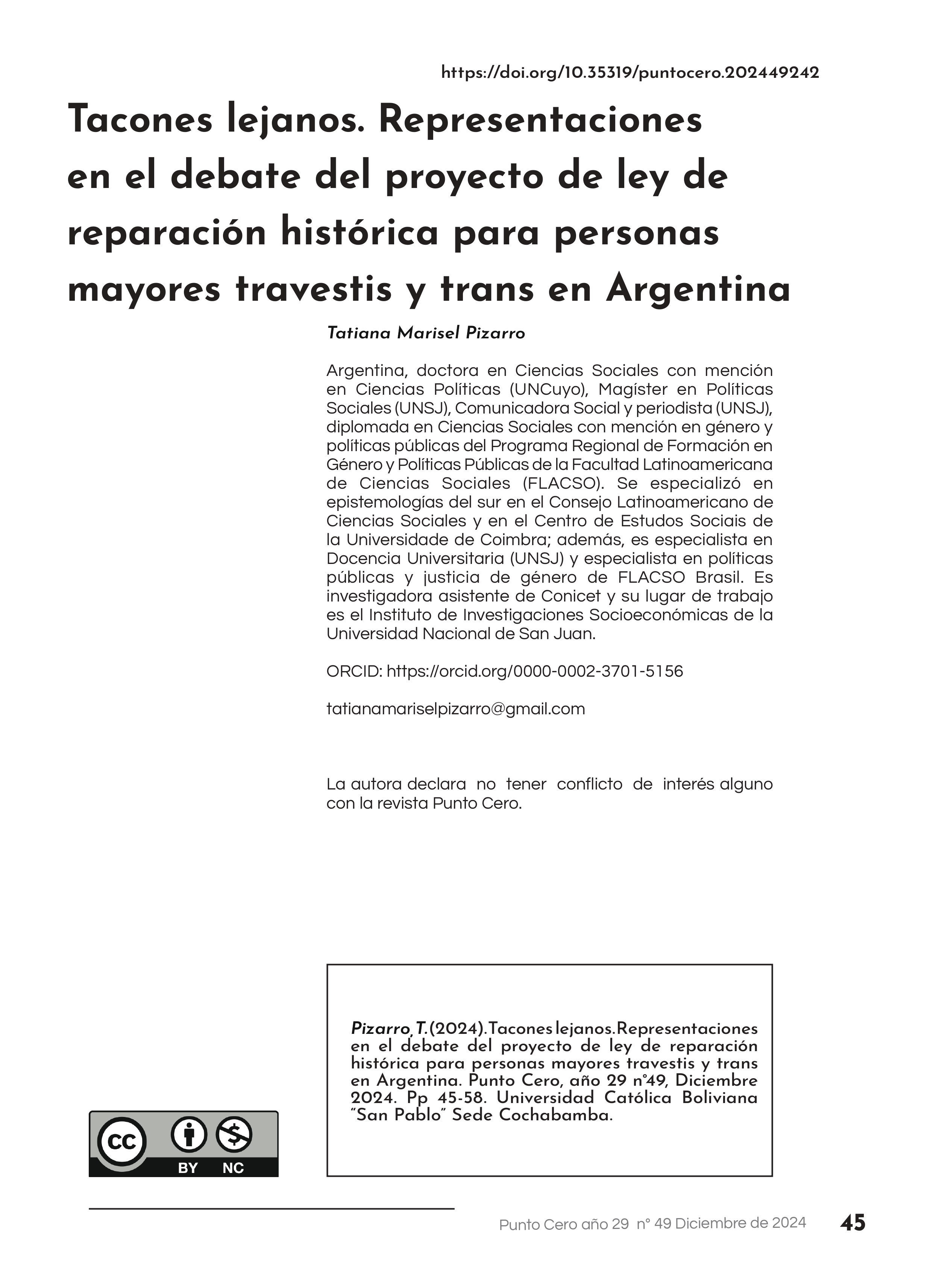High heels. Representations in the debate of the historical reparation bill for elderly transgender and trans individuals in Argentina
DOI:
https://doi.org/10.35319/puntocero.202449242Keywords:
LGBTIQ Rights, Sociodiscursives Representations, Identities, Transvestite-Trans Collective, Public PolicyAbstract
This article aims to analyze the socio-discursive representations that have emerged in the legislative debate on the bill for historical reparations for elderly transgender and trans individuals in Argentina as tools of recognition through the creation of the Reparatory Pension for Elderly Transgender and Trans Individuals, who could potentially be beneficiaries. In Argentina, eleven years after the enactment of Law 26.743 which establishes the right to gender identity for individuals, various transgender and trans activist groups are advocating for a Historical Reparations Law as a form of compensatory indemnification that seeks to address the harm caused by institutional violence suffered by this community due to their gender identity and the violation of their human rights. The analysis of socio-discursive representations in the discursive treatment of this bill in the Chamber of Deputies is of great importance for identifying and studying tools against discrimination, the processes of impoverishment of transgender and trans individuals, and the recognition of rights. The analysis of the legislative discourses that took place on May 24, 2023, and will continue in mid-June 2023, aims to delve into the evolution of the resignifications of the recognition of the rights of this community with the possibility of granting a reparatory pension on a lifelong basis.
References
Berkins, L. (2013). “Los existenciarios trans”. En A. M. Fernández y W. Siqueira Peres (Eds.), La diferencia desquiciada: Géneros y diversidades sexuales (pp. 91-96). Buenos Aires: Biblos.
Berkins, L. (Comp.). (2015). Cumbia, copeteo y lágrimas: Informe nacional sobre la situación de las travestis, transexuales y transgéneros (2ª ed.). Buenos Aires: Ediciones Madres de Plaza de Mayo.
Berkins, L., & Fernández, J. (Coords.). (2005). La gesta del nombre propio: Informe sobre la situación de la comunidad travesti en Argentina. Buenos Aires: Ediciones Madres de Plaza de Mayo.
DiPietro, J. P., & Wayar, M. (2023). Género, TransGénero, y PostGénero en las Políticas del Cuerpo y las Disidencias en las Américas Latinas (PRIGEPP). Recuperado de http://prigepp.org
Halberstam, J. (2008). Masculinidad femenina. Madrid: Egals [1998. Female Masculinity. United States of America: Duke University Press].
Instituto Nacional de Estadísticas y Censos (INDEC). (2012). Primera Encuesta sobre Población Trans-2012: Travestis, Transexuales, Transgéneros y Hombres Trans. Informe técnico de la Prueba Piloto. Municipio de La Matanza, 18 al 29 de junio de 2012. Buenos Aires: INDEC-INADI.
Maffía, D. (2008). Contra las dicotomías: Feminismo y epistemología crítica. Recuperado de http://dianamaffia.com.ar/archivos/Contra-las-dicotom%C3%ADas.-Feminismo-y-epistemolog%C3%ADa-cr%C3%ADtica.pdf
Malva. (2009). De Grafa a los escándalos en las revistas. El Teje, 4, 12.
Martínez Guzmán, A. e Íñiguez Rueda, L. (2010). La fabricación del Trastorno de Identidad Sexual. Estrategias discursivas en la patologización de la transexualidad. Discurso & Sociedad, Vol. 4 (1), pp. 30-51. DOI: https://doi.org/10.14198/dissoc.4.1.2
Ministerio Público Fiscal. (2016). Informe sobre la investigación del femicidio de Diana Sacayán. Recuperado de https://www.fiscales.gob.ar/wp-content/uploads/2016/02/Informe-CIDH-caso-Sacayan.pdf
Rapisardi, F., & Modarelli, A. (2001). Fiestas, baños y exilios: Los gays porteños en la última dictadura. Buenos Aires: Sudamericana.
Rueda, A., & Serbia, J. M. (2014). El trasfondo de la seguridad pública. Debate Público: Reflexión de Trabajo Social, 4(7), 61-74.
Scott, Joan (2010) “Género: ¿Todavía una categoría útil para el análisis?”, La manzana en discordia, Año 2011, Volumen 6, Número 1, pp. 95-101. DOI: https://doi.org/10.25100/lmd.v6i1.1514
Secretaría de Derechos Humanos de la Nación. (2015). Guía de derechos para personas trans (guía de bolsillo). Recuperado de http://www.jus.gob.ar/media/3120651/cartilla_trans_web.pdf
Soley-Beltran, P. (2009) Transexualidad y la Matriz Heterosexual: un estudio crítico de Judith Butler, Edicions Bellaterra, Barcelona.
Stryker, S., Currah, P. y Moore, L. J. (2008). Introduction: trans-, trans, or transgender? WSQ: Women’s Studies Quarterly 36, no. 3, pp. 11-22. DOI: https://doi.org/10.1353/wsq.0.0112
Wayar, M. (2018). Travesti / Una teoría lo suficientemente buena. Buenos Aires: Editorial Muchas Nueces.
Whittle, S. (2002). Respect and Equality. Transsexual and Transgender Rights. Abingdon – Nueva York: Routledge-Cavendish.

Downloads
Published
How to Cite
Issue
Section
License
Copyright (c) 2024 Revista Punto Cero

This work is licensed under a Creative Commons Attribution-NonCommercial 4.0 International License.








